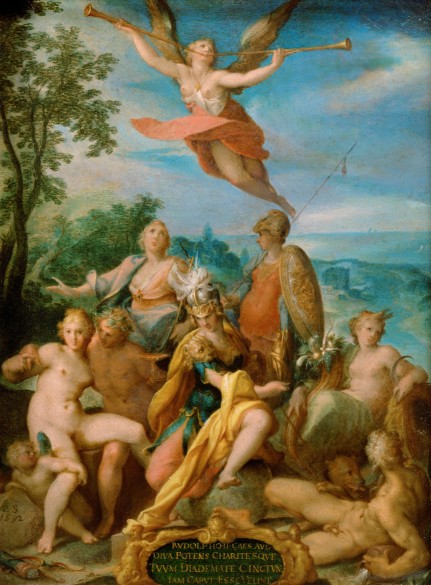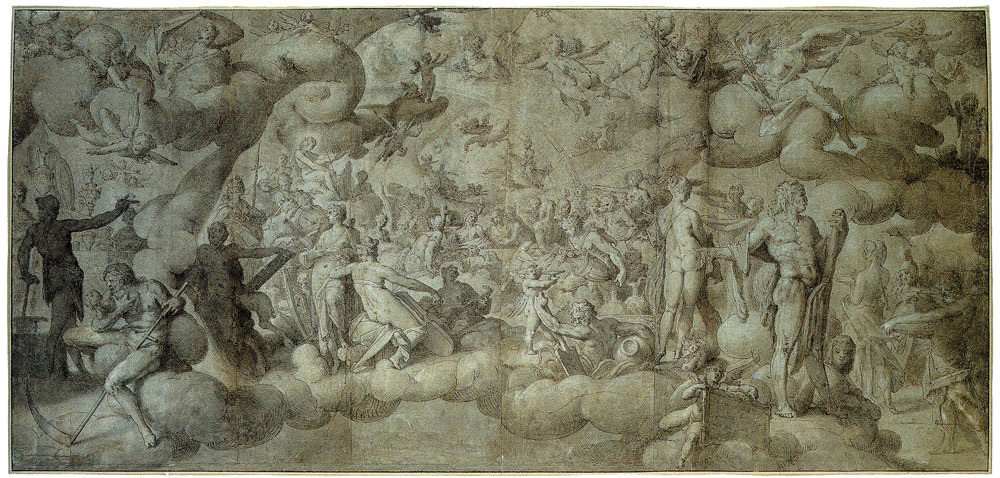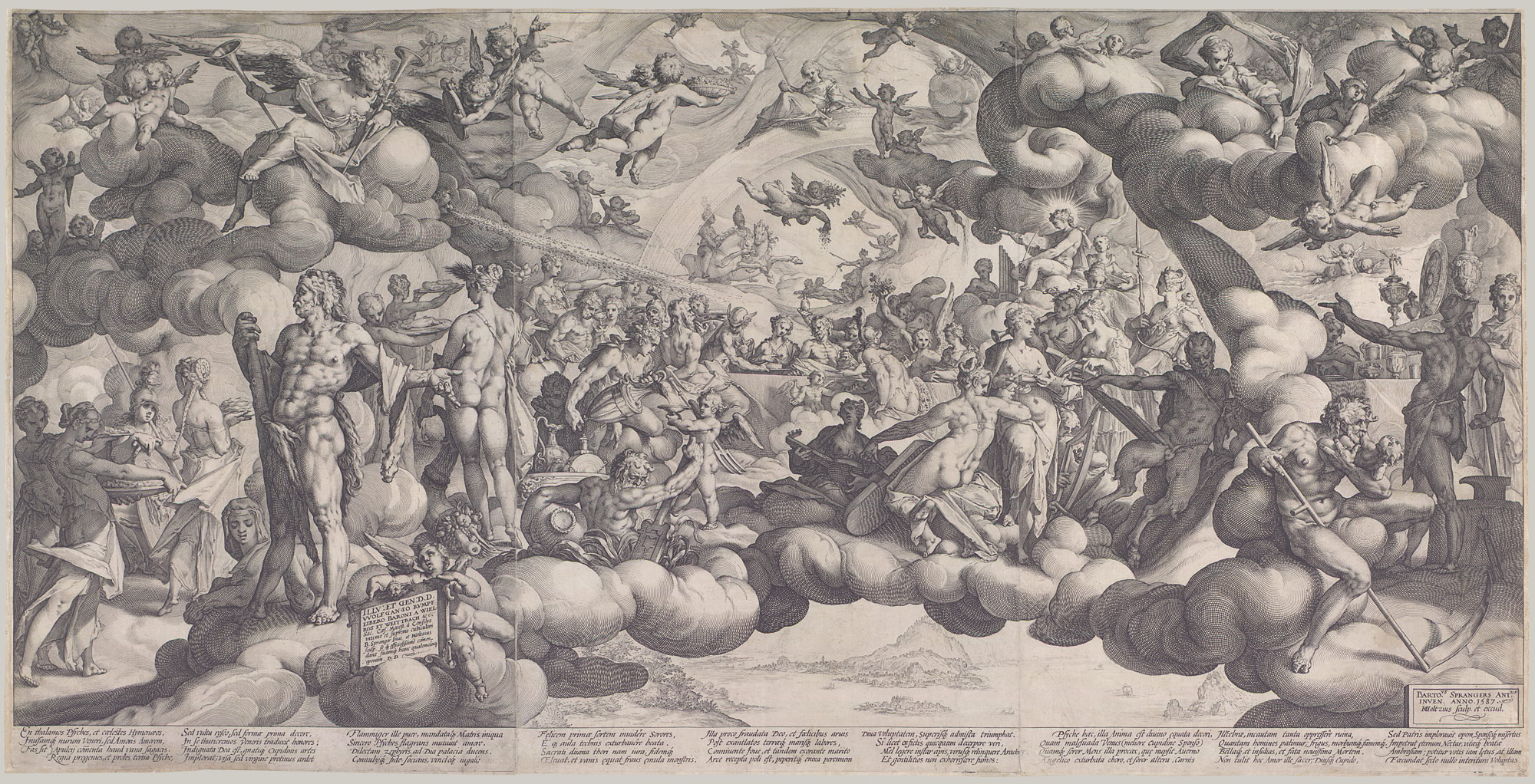Bartholomeus Spranger: Splendor and Eroticism in Imperial Prague, the first major exhibition devoted to this fascinating artist who served a cardinal, a pope, and two Holy Roman Emperors, is on view at The Metropolitan Museum of Art. Bartholomeus Spranger (1546–1611) emerged as one of the most prominent artists at the court of Rudolf II in Prague and the most significant Northern Mannerist artist of his generation. The exhibition will examine his remarkable career through a selection of his rare paintings, drawings, and etchings, most of which will be on loan from international museums and private collections. Adding a unique dimension to the exhibition will be works by artists who helped shape Spranger’s artistic horizon. A kunstkammer, or chamber of wonders, will also be created in the exhibition featuring exotic objects from nature along with works by various artists.
As the leader and founder of the Prague School, Spranger represents a major force in European art in the late 16th century. He was the brilliant star in a galaxy of artists surrounding Emperor Rudolf II, composing works imbued with eroticism and erudition. An excellent painter, draftsman, and etcher, Spranger employed a bravura technique and elegant style, and the exhibition will showcase his mastery of these diverse methods. He also had an immense aptitude for composing allegories featuring amorous couples entwined in complicated and seemingly impossible poses. The exhibition will include works of this kind as well as several newly rediscovered works by Spranger that enlarge our understanding of his artistic development.
Born in Antwerp in 1546, Spranger began his artistic career as an apprentice to obscure Netherlandish painters from whom he learned the traditions of landscape painting. During a decade-long sojourn in Italy in the 1560s, Spranger studied with Guilio Clovio (who was also El Greco’s mentor) and garnered the illustrious patronage of Cardinal Alessandro Farnese and Pope Pius V. He reached the apogee of his fame when he headed north: first in Vienna, where he was appointed court painter by the Holy Roman Emperor Maximilian II, who died shortly after Spranger’s arrival in 1576, and then in Prague, where he became court artist for Rudolf II in the early 1580s. Once established in Prague, Spranger became a celebrated painter and draftsman, and his figural style, chiefly aligned with Italian Mannerism, wielded wide influence throughout Europe.
A selection of works from Spranger’s years in Italy includes his paintings The Conversion of St. Paul (ca. 1572), from the Ambrosiana in Milan;
the Holy Family (ca. 1569–1574), a miniature on copper from the Galleria Pallatina in Florence; and
the Flight into Egypt (ca. 1570), from the Musées Royaux des Beaux-Arts, in Brussels.
Works from Spranger’s mature period comprise the bulk of the exhibition and include the paintings
Venus and Vulcan (ca. 1595)
and the Allegory of the Reign of Rudolf II (1592), both from the Kunsthistorisches Museum in Vienna;
and The Baptism of Christ (1603), from the National Museum in Wroclaw, Poland;
as well as a selection of master drawings, such as Hercules and Omphale from the Národní Galerie in Prague
and The Wedding of Cupid and Psyche (ca. 1585), from the Rijksmuseum in Amsterdam.
Spranger was an outstanding draftsman, and his drawings and engravings will be a focus of the exhibition. One of his most exquisite drawings,
the Metropolitan Museum’s Diana and Actaeon (ca. 1590–95),
is a highlight, as well as other works on paper from the Museum’s collection, which holds the largest number of Spranger’s works in the United States.
The kunstkammer, or chamber of wonders, will be specially created for the exhibition. Rudolf II had an unquenchable thirst for art and gathered a magnificent collection of paintings, drawings, sculpture, engravings, and objets de vertu (rare and beautiful curiosities) into four rooms in Prague Castle, known as the kunstkammer. The collection reached beyond the fine arts to embrace scientific specimens, demonstrating the miracles of nature and God. Rudolf displayed the paintings and taxidermic specimens together, to signify his mastery of the universe. Stuffed birds, musical instruments, and skeletons, as seen in the cabinet, were celebrated for their intellectual content and inherent beauty, and examples of these will be in the exhibition.
To emphasize Spranger’s impact on other artists, the exhibition also features sculpture and engravings by, for example, Hendrick Goltzius (1558–1617)—the leading engraver of the Haarlem Mannerists—and Jan Muller (1571–1628), who through their master engravings, were among the major protagonists in promoting Spranger’s designs.
The exhibition includes a large, rare sheet capturing Spranger’s preparatory design for the master engraving by Hendrick Goltzius of his Feast of the Gods at the Wedding of Cupid and Psyche (1587). A composition comprised of nearly 180 figures, this work inspired a wave of artistic inspiration throughout Europe, resulting in numerous copies.
From an interesting review in the NY Times: (image added)

Among the most captivating of Spranger’s early works is “The Lamentation of Christ” (about 1576). Measuring a little under 6 by 5 inches, it’s a marvel of compositional concentration, with not a square millimeter of wasted surface. Jesus’ muscular, light-dappled body lies back in the arms of mourners, his legs filling the foreground. A raised knee seems to project into the viewer’s real space. A window in the upper right corner affords a distant view of the Crucifixion in a bleak landscape rendered in almost microscopic detail.
Bartholomeus Spranger (Flemish, Antwerp 1546-1611 Prague)Hercules and OmphaleCa. 1585Oil on copper9 1/2 x 7 1/2 in. (24 x 19 cm) Kunsthistorisches Museum, Vienna, Austria
A later small painting, “Hercules and Omphale” (about 1585), is decidedly less conventional. In an opulent bedroom, the lithe Omphale, whom Hercules has been condemned to serve by the Delphic oracle, stands naked with her back to the viewer holding his club over her shoulder like a baseball player awaiting the next pitch. Hercules sits to the left wearing a feminine pink frock; he’s handling spinning implements, performing an activity ordinarily reserved for women.
Beautifully painted on a paperback-size copper panel, it’s a funny picture of gender role reversal, but there’s more to it than just screwball comedy — or, at least, there was for its intended, culturally sophisticated audience. After establishing his court in Prague, Rudolf II gathered about him a glittering entourage of artists, intellectuals, scientists, quacks and charlatans. An exceptionally erudite, psychologically fragile libertine, Rudolf was especially drawn to occult studies like alchemy, astrology and the kabbalah, and it’s in light of those interests that Spranger’s erotically provocative mythic images were understood by the initiated.
More Images from the exhibition:
Bartholomeus Spranger (Flemish, Antwerp 1546–1611 Prague)
Jupiter and Antiope
Ca. 1595–97
Oil on canvas
47 1/4 x 35 in. (120 x 89 cm)
Kunsthistorisches Museum, Vienna, Austria
Bartholomeus Spranger (Flemish, Antwerp 1546-1611 Prague)
Self-Portrait
1585–86
Oil on canvas
24 5/8 x 17 5/8 in. (62.5 x 45 cm)
Kunsthistorisches Museum, Vienna, Austria
Bartholomeus Spranger (Flemish, Antwerp 1546-1611 Prague)
Judith and Holofernes
Ca. 1601
Pen and brown ink with brown wash and white heightening on paper
rubbed with black chalk and brown wash
12 5/8 x 8 3/8 in. (32.1 x 21.4 cm)
Musée du Louvre, Paris, France
Bartholomeus Spranger (Flemish, Antwerp 1546–1611 Prague)
Cupid Fleeing Psyche
Ca. 1599
Oil on copper,
24 3⁄4 x 18 5⁄8 in. (63 x 47.5 cm)
Landesmuseum für Kunst und Kulturgeschichte
Oldenburg (15.579)
Exhibition Credits
Bartholomeus Spranger: Splendor and Eroticism in Imperial Prague is organized by guest curator Sally Metzler.
Publication
The exhibition is accompanied by a catalogue, the first monograph of Bartholomeus Spranger. It is published by The Metropolitan Museum of Art and distributed by Yale University Press.













